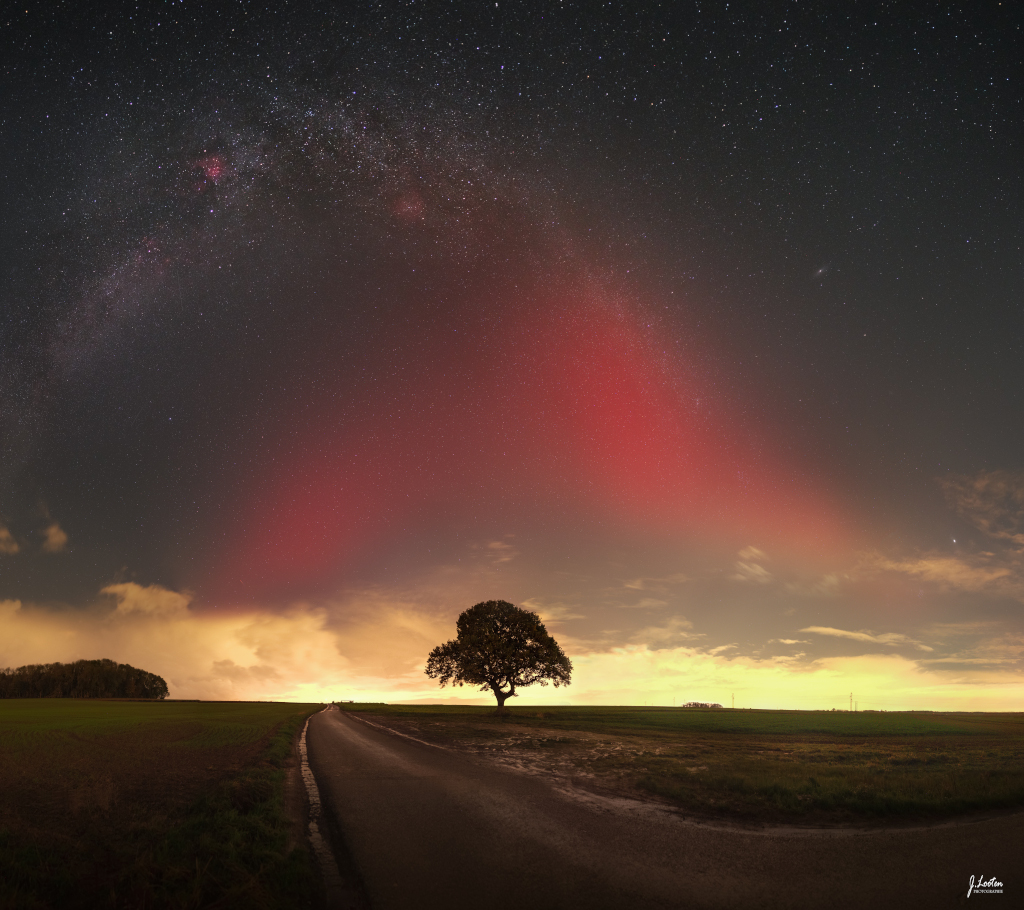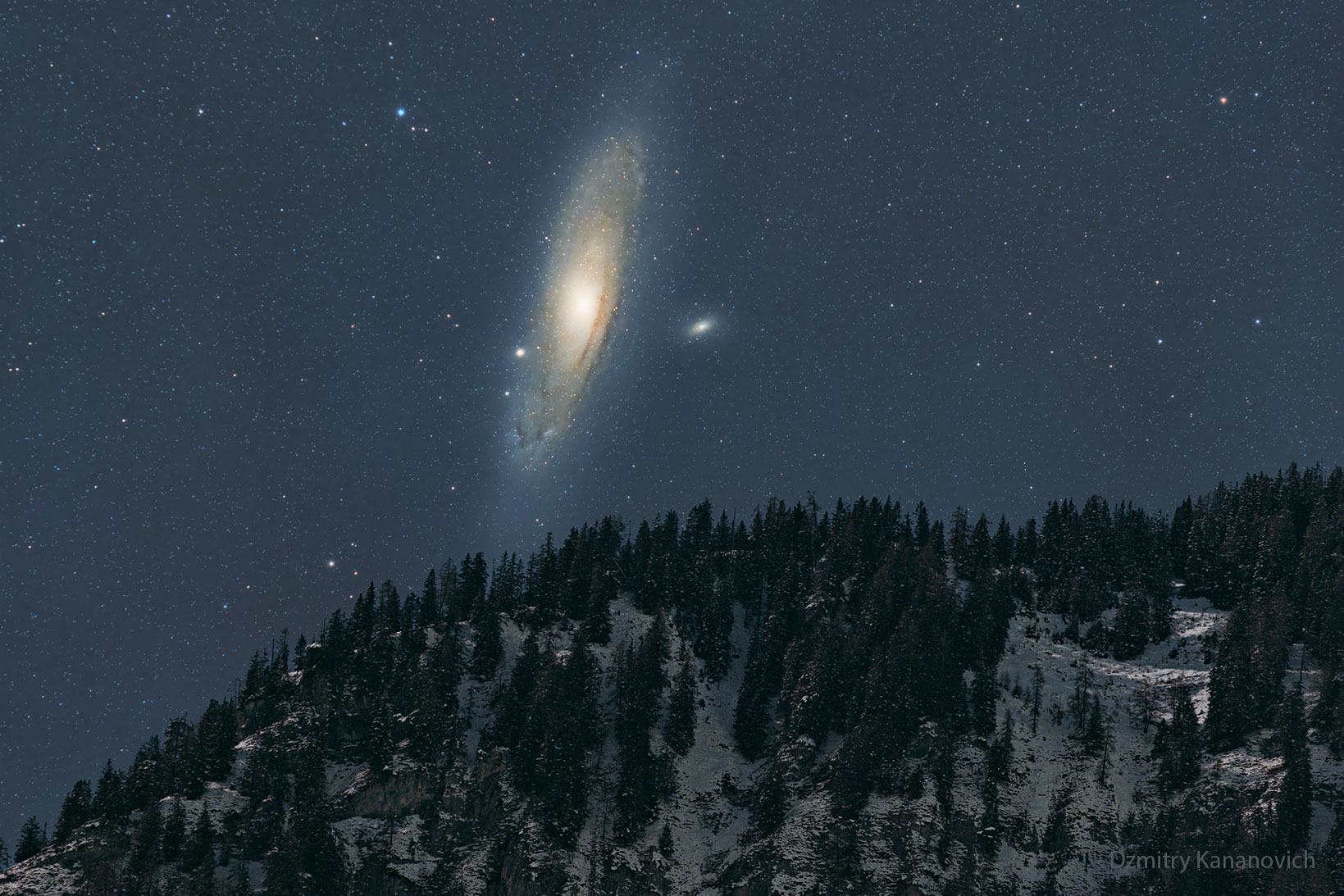George Andrew Cables (born November 14, 1944) is an American jazz pianist and composer. NY, NY
see full post...
see full post...Ellis Louis Marsalis Jr. (November 14, 1934 – April 1, 2020) NOLA, LAwas an American jazz pianist and educator. Active since the late 1940s, Marsalis came to greater attention in the 1980s and 1990s as the patriarch of the musical Marsalis family, when sons Branford and Wynton became popular jazz musicians.
see full post...Have you ever seen the Andromeda galaxy? Although M31 appears as a faint and fuzzy blob to the unaided eye, the light you see will be over two million years old, making it likely the oldest light you ever will see directly. The featured image captured Andromeda just before it set behind the Swiss Alpsearly last year. As cool as it may be to see this neighboring galaxy to our Milky Way with your own eyes, long duration camera exposures can pick up many faint and breathtaking details. The image is composite of foreground and background images taken consecutively with the same camera and from the same location. Recent data indicate that our Milky WayGalaxy will collide and coalesce with Andromeda galaxy in a few billion years.
John Paul Hammond (born November 13, 1942 in New York City) is an American singer and musician. The son of record producer John H. Hammond, he is sometimes referred to as John Hammond Jr.
see full post...Idris Muhammad was born on November 13,1939-July 29th 2014
and began playing the drums at age 8 in his native New Orleans. By the time he was 16, he was performing in jazz bands. Muhammad became known as one of the most innovative drummers in soul music of the 1960’s, performing with singers Sam Cooke, Jerry Butler, and The Impressions. He played for the popular musical Hair while performing with the house band for the Prestige Label in the early 1970’s. For the rest of that decade, he accompanied popular singer Roberta Flack, led his own band, and worked with Johnny Griffin and Pharaoh Sanders. An excellent drummer who has appeared in many types of settings, Idris Muhammad became a professional when he was 16. He played primarily soul and R&B during 1962-1964 and then spent 1965-1967 as a member of Lou Donaldson’s band. He was the house drummer at Prestige Records (1970-1972), appearing on many albums as a sideman. Of his later jazz associations, Muhammad played with Johnny Griffin (1978-1979), Pharoah Sanders in the 1980s, George Coleman, and the Paris Reunion Band (1986-1988). He has recorded everything from post-bop to dance music as a leader for such labels as Prestige, Kudu, Fantasy, Theresa, and Lipstick. Muhammad’s 1993 recording My Turn includes saxophonist Grover Washington, Jr. and trumpetor Randy Brecker, both of whom are also featured performers in this year’s 25th Annual University of Pittsburgh Jazz Seminar and Concert.
see full post...Hampton Barnett Hawes Jr.(November 13, 1928 – May 22, 1977) LA, CA was an American jazz pianist. He was the author of the memoir Raise Up Off Me, which won the Deems-Taylor Award for music writing in 1975.
https://youtu.be/vGjVondfCUk?si=wB86BMmcEhggDd-J
see full post...Diwali, one of the most popular Hindu festivals, is celebrated by devotees all over the world. Also known as the festival of lights, it symbolises the victory of good over evil and commemorates Lord Ram’s return to the Ayodhya kingdom after a 14-year exile.

WR 134 is a variable Wolf-Rayet star located around 6,000 light years away from Earth in the constellation of Cygnus, surrounded by a faint bubble nebula blown by the intense radiation and fast wind from the star.
This nebula is surrounded by Halpha emission, giving that red background to the Oiii blue bubble.

Baaba Maal (Fula: , born 13 June 1953) is a Senegalese singer and guitarist born in Podor, on the Senegal River. In addition to acoustic guitar, he also plays percussion. He has released several albums, both for independent and major labels. In July 2003, he was made a UNDP Youth Emissary.
Maal sings primarily in Pulaar and promotes the traditions of the Pulaar-speaking people, who live on either side of the Senegal River in the ancient Senegalese kingdom of Futa Tooro.
Maal was expected to follow in his father’s profession and become a fisherman. However, under the influence of his lifelong friend and family gawlo, blind guitarist Mansour Seck, Maal devoted himself to learning music from his mother and his school’s headmaster. He went on to study music at the university in Dakar before leaving for a three month stay in Paris to learn musical notation. In the event, he stayed for three years in the French capital, where he took courses at the Conservatoire de Paris, had private tuition and was taken with Mozart.
see full post...Neil Percival Young OC OM (born November 12, 1945) is a Canadian and American singer and songwriter. After embarking on a music career in Winnipeg in the 1960s, Young moved to Los Angeles, joining the folk-rock group Buffalo Springfield. Since the beginning of his solo career, often with backing by the band Crazy Horse, he has released critically acclaimed albums such as Everybody Knows This Is Nowhere (1969), After the Gold Rush (1970), Harvest (1972), On the Beach (1974), and Rust Never Sleeps(1979). He was also a part-time member of Crosby, Stills, Nash & Young, with whom he recorded the chart-topping 1970 album Déjà Vu.
His guitar work, deeply personal lyrics and signature high tenor singing voice define his long career. Young also plays piano and harmonica on many albums, which frequently combine folk, rock, countryand other musical genres. His often distorted electric guitar playing, especially with Crazy Horse, earned him the nickname “Godfather of Grunge“ and led to his 1995 album Mirror Ball with Pearl Jam. More recently he has been backed by Promise of the Real.
Young directed (or co-directed) films using the pseudonym “Bernard Shakey”, including Journey Through the Past (1973), Rust Never Sleeps (1979), Human Highway (1982), Greendale (2003), CSNY/Déjà Vu (2008), and Harvest Time (2022). He also contributed to the soundtracks of the films Philadelphia (1993) and Dead Man (1995).
Young has received several Grammy and Juno Awards. The Rock and Roll Hall of Fame inducted him twice: in 1995 as a solo artist and in 1997 as a member of Buffalo Springfield. In 2023, Rolling Stone named Young No. 30 on their list of 250 greatest guitarists of all time. Young is also on Rolling Stone’s list of the 100 greatest musical artists. According to Acclaimed Music, he is the seventh most celebrated artist in popular music history. 21 of his albums and singles have been certified Gold and Platinum in U.S. by RIAA certification. Young was awarded the Order of Manitoba in 2006 and was made an Officer of the Order of Canada in 2009.
see full post...Samuel Jones (November 12, 1924 – December 15, 1981) was an American jazz double bassist, cellist, and composer.
Sam Jones was born in Jacksonville, Florida, United States, to a musical family. His father played piano and drums and his aunt played organ in church. In 1955, he moved to New York City and began his recording career with Tiny Bradshaw, before working with Bill Evans, Bobby Timmons, Les Jazz Modes, Kenny Dorham, Illinois Jacquet, Freddie Hubbard, Dizzy Gillespie (1958–59), and Thelonious Monk. He is probably best known for his work with Cannonball Adderley, performing in his quintet from 1955 to 1956 and then again from 1959 to 1964, and recording extensively for Riverside Records as both a leader and sideman. He later spent several years working with Oscar Peterson (1966-1970) and Cedar Walton (1972-1977). In the 1970s, Jones recorded several albums as a bandleader for the Xanadu and SteepleChaselabels. Jones wrote the jazz standards “Del Sasser” and “Unit 7” while working with Adderley. Other compositions include “Blue Funk”, “O.P.”, “Bittersweet”, and “Seven Minds”. He died of lung cancer in 1981 at the age of 57.
see full post...Booker T. Washington “Bukka” White (born on November 12, between 1900 and 1909; died February 26, 1977) was an American Delta blues guitarist and singer.
Booker T. Washington White was born on a farm south of Houston, in northeastern Mississippi. He was born on November 12; various years between 1900 and 1909 are recorded – census data suggests 1904. Bukka is a phonetic spelling of White’s first name; he was named after the African-American educator and civil rights activist Booker T. Washington. White was a first cousin of B.B. King‘s mother (White’s mother and King’s maternal grandmother were sisters). His father John White was a railroad worker, and also a musician who performed locally, primarily playing the fiddle, but also mandolin, guitar and piano. He gave Booker a guitar for his ninth birthday. White started his career playing the fiddle at square dances. He got married at 16 years old, with his father giving him a new Stella guitar as a wedding present. He and his wife lived at Houston, but after a few years she died of a burst appendix.
see full post...Honoring my dad Mike Labriola a WWII US Army veteran stationed in his homeland of Italy. Devastated & traumatized. Praying for Peace for Ukraine, Palestine and Israel. In addition to the total of 32 ongoing conflicts in the world right now, ranging from drug wars, terrorist insurgencies, ethnic conflicts, and civil wars. When will this stop?

see full post...
This broad, luminous red arc was a surprising visitor to partly cloudy evening skies over northern France. Captured extending toward the zenith in a west-to-east mosaic of images from November 5, the faint atmospheric ribbon of light is an example of a Stable Auroral Red (SAR) arc. The rare night sky phenomenon was also spotted at unusually low latitudes around world, along with more dynamic auroral displays during an intense geomagnetic storm. SAR arcs and their relation to auroral emission have been explored by citizen science and satellite investigations. From altitudes substantially above the normal auroral glow, the deep red SAR emission is thought to be caused by strong heating due to currents flowing in planet Earth’s inner magnetosphere. Beyond this SAR, the Milky Way arcs above the cloud banks along the horizon, a regular visitor to night skies over northern France.

